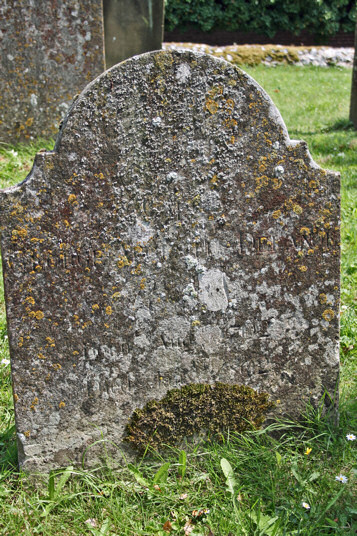Graveyard Monuments and Inscriptions Project
| CARD Number | Image |
Inscription & Additional Information |
| 176 |  |
CAPT. Limestone headstone with curved top Additional Document- Extract from "CIVIL HISTORY OF THE ROYAL NAVY, 1793-1802" - Portrait of Captain Delanoe and text from website visitor Harold Ward, from Grantham. |
Captain George Augustus Delanoe RN1797. MUTINY AT THE NORE (a Royal Navy Anchorage in the Thames).Extract from "CIVIL HISTORY OF THE ROYAL NAVY, 1793-1802" [Page 175] "It was on June 6th that two Acts of Parliament were hastily introduced, passed, and assented to. One was "for the better prevention and punishment of attempts to seduce persons serving in his Majesty's forces by sea or land from their duty and allegiance, or to entice them to mutiny or disobedience"; and the other was "for the more effectually restraining intercourse with the crews of certain of his Majesty's ships now in a state of mutiny and rebellion, and for the effectual suppression of such mutiny and rebellion." In pursuance of the intention of the authorities to crush the outbreak at all costs, new batteries were erected on both sides of the Thames; the buoys at its mouth were removed; furnaces for heating shot were prepared at various points; and the Neptune, 98, Commodore Sir Erasmus Gower, Lancaster, 64, Agincourt, 64, and several gunboats, which lay near Gravesend, were directed to drop down and attack the insurgents. The mutineers, feeling that the end was approaching, opened negotiations through the Earl of Northesk, Captain of the Monmouth; but still simulated an uncompromising demeanour. Their overtures were rejected ; and the preparations for reducing them by force were almost complete when, on June 9th, it became apparent that the insurrection was about to collapse. On that day the Repulse and Leopard escaped from the fleet, the latter getting up the Thames, but the former, unfortunately, taking the ground, and being fired at by the Monmouth and Director. In the following night the Ardent also made off, though she, too, was fired at by the Monmouth. Both in her and in the Repulse several people were hit. On the 10th, several vessels hauled down the red flag, and the river traffic was reopened. On the 12th, other ships struck the symbol of disaffection, and expressed a desire to submit ; and on the evening of that day the rebels had only seven ships still adhering to them. Early on the 13th, the Agamemnon, Standard, Nassau, Iris, and Vestal, after there had been bloody struggles in most of them, took refuge either up the Thames or under the guns of Sheerness ; and, later on the same day, the general body of rebels, even including the crew of the Sandtcich, announced an inclination to submit if a general pardon should be granted. On the morning of the 14th, the Sandwich was carried under the guns of Sheerness, and Vice-Admiral Buckner, sending a boat full of soldiers on board of her, effected the arrest of Richard Parker, of a man named Davies, who had acted as his flag-captain, and of about thirty other delegates. One delegate, named Wallace, to escape capture, committed suicide. Parker was tried by court- martial on board the Sandwich on June 22nd. The trial continued for several days, and resulted in the man's condemnation to death. He was executed on June 29th on board the Sandwich, and died acknowledging the justice of the sentence. Other mutineers were then tried. Many were executed ; several were flogged from ship to ship ; some were imprisoned in the Marshalsea ; and a number remained under sentence on board the Eagle, 64, prison ship in the Medway, until after the battle of Camperdown, when, at the prayer of Admiral Duncan, the King was pleased to pardon them. Footnotes: Lieutenant George Augustus Delanoe, of the Repulse, lost a leg on the occasion. He was in consequence promoted and given a pension of 2s. a day. He was also granted a pension by the City of London. He was promoted in the course of the year, and died, still a Commander, in 1802." The numbers following the names of the larger ships indicate the number of guns, and hence the size of the ship. Speculative NotesReading between the lines, it seems that Delanoe (and presumably his fellow officers) were imprisoned on the Repulse by the mutinous ratings. He was wounded by fire from the Monmouth, whose captain did not realise the Repulse was trying to escape from the mutineers at the time of the engagement. Also that D's family buried him with the rank of Captain, although he had not lived long enough to assume the rank to which he had been promoted. Was he a native son of Lynsted, I wonder. Additional material from Mr Harold Ward of Grantham - June 2013Harold Ward wrote to the Society enclosing the portrait (below) of Captain Delanoe, adding the following: "Capt George Delanoe Royal Navy. Painted 1794 Oh Lord at all times most fervently pray we may each day be better prepared to meet thee. George Harnage, Cambridge April 4th 1842. Capt. Geo Delanoe buried at Linstead Jan 10th 1802.
Textual explanations1. The Neptune-class ships of the line were a class of three 98-gun second rates, designed for the Royal Navy by Sir John Henslow. Namely HMS Neptune, Temeraire, and Dreadnaught. All three took part in the Battle of Trafalgar, 1805. 2. Other sources suggest that Delanoe was the only injured party on HMS Repulse, in spite of coming under fire from the fleet while stuck on a sand-bank for one and a half hours after trying to make good their escape from the Mutiny! |
||


.png)